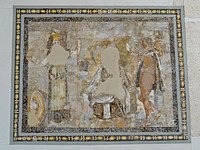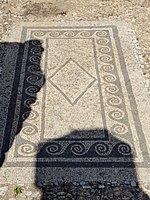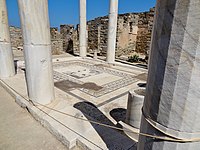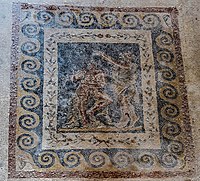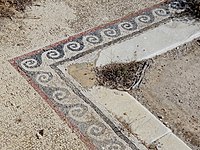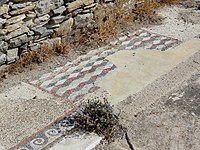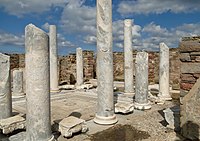Mosaics of Delos
The mosaics of Delos are a significant body of
The paved walkways of Delos range from simple
Although there are minor traces of
Dating
Right: a Delian mosaic with pigeons flocking around a bowl, Archaeological Museum of Delos
Archaeological excavations of Delos by the French School at Athens began in 1872,[4] with initial descriptions of the mosaics published in a report by French archaeologist Jacques Albert Lebègue in 1876.[5] Precisely 354 mosaics from Delos survive and have been studied by French archaeologist Philippe Bruneau.[2][6][7] Most date to the late Hellenistic period, contemporaneous with the late Roman Republic (i.e. the last half of the 2nd century BC and early 1st century BC).[2][6][8][9][10] A handful were dated to the Classical period,[6] with one mosaic attributed to the Imperial Roman era.[6] Bruneau believed that nominally undated pieces, on the basis of their styles, were produced within the same period as majority of examples, roughly between 133 and 88 BC.[6]
In 167 or 166 BC, after the
Characteristics
Composition
The composition of the Delos mosaics and pavements include simple

Arrangement and location
While some mosaics have been unearthed from

Patterns and motifs
Among the various patterns and motifs found in Delian mosaics is the triple-colored lozenge that creates a three-dimensional illusion of cubes in perspective for the viewer.[1][2] This pattern appears in fifteen different locations, making it one of the most common.[1] Other motifs include waves and stepped triangles, while major themes include maritime, theatrical, natural, or mythological objects and figures.[24] The single wave pattern, a common motif in Hellenistic art, is the most predominant type of border design for mosaics at Delos and can be found at other sites such as Arsameia (albeit arranged in the opposite direction).[14][26] The rosette motif, which is found in the mosaics of various Hellenistic sites across the Mediterranean, is often coupled with single-wave borders in Delian mosaics.[25] The typical Hellenistic palmette motif is used in a mosaic of Delos to fill the four corners around a central rosette motif.[27] The illusion of three-dimensional relief in the figured scenes of Delian mosaics was usually achieved by the use of polychrome, with white, black, yellow, red, blue and green hues.[14]
The origins of the composition, techniques, layout, and style of Delian mosaics can be found in 5th-century BC
Culture and ethnic origins
Aside from a symbol of the
Significance
The surviving corpus of Hellenistic mosaic art
The French archaeologist
Ruth Westgate writes that Delos contains roughly half of all surviving tessellated Greek mosaics from the Hellenistic period.
Comparisons with Roman Pompeii
Right image: detail of Alexander the Great, from the Alexander Mosaic, House of the Faun, Pompeii
In her comparative analysis of mosaic art in the Greco-Roman world, Hetty Joyce chose the mosaics of Delos and Roman Pompeii as chief representative samples for determining distinctions in the form, function, and production techniques of mosaics in the Greek East and Latin West.[38] Her reasoning for the selection of these two sites are their well-preserved pavements, the secure dating of the samples to the late 2nd and early 1st centuries BC, and, thanks to the extensive documentation of Delian mosaics by Bruneau, a sufficient amount of academic literature dedicated to each site to form comparisons.[39] Ruth Westgate, in her survey and comparative study of Hellenistic Greek mosaics with mosaics of Pompeii, concludes that the Roman mosaics, dated to the Pompeian First Style of wall painting in the late 2nd and early 1st centuries BC, were derived from the Greek tradition.[40] However, she stresses that Pompeian mosaics departed from their Greek counterparts by almost exclusively featuring figured scenes instead of abstract designs, in plain pavement most likely set by local craftsmen and produced separately from the figured panels, the latter of which were perhaps made by Greek artisans for their Roman patrons.[41]
Due to the similarities between the Hellenistic wall paintings at Delos and the First Style of Pompeii, Joyce contends that the differences in Delian and Pompeian mosaics are the deliberate product of artistic preference rather than the result of ignorance of each other's traditions.
Connections to other mediums of ancient Greek art
Red-figure pottery was no longer produced by the time the Delos mosaics were made. The black background technique of red-figure pottery was still appreciated in 4th-century-BC Macedonian pebble mosaics from Pella and in mosaics at Delos, such as the white-figured Triton mosaic with tesserae.[45] The black background technique was later used in glass art such as cameo glass, particularly Roman glass (e.g. Portland Vase, Gemma Augustea, Great Cameo of France, etc.).[45]
The undulating
Houses and city quarters
Mosaics from the Northern Quarter
The northern quarter of Delos contains the Jewelry Quarter, where older structures such as workshops and other archaeological remains dating to the 3rd century BC and early 2nd century BC have been discovered.[49] By the second half of the 2nd century BC these were replaced by private homes built in the most characteristic fashion for Delos: a narrow, rectangular floor plan with a central courtyard, a vestibule service room in the front, and a larger, main room in the rear. The quarter of the House of the Masks is the only area of Delos without this archetypal house plan.[50] Some houses of the Northern Quarter feature mosaic decorations with mythological scenes, including Lycurgus of Thrace and Ambrosia in an upper-story mosaic, as well as Athena and Hermes together with a seated woman in a main-room mosaic.[24]
-
Detail of a mosaic from the Jewelry Quarter of Delos depicting a bull's head with foliage
-
Detail of a mosaic from the Jewelry Quarter of Delos depicting an ancient Greek theatre mask
-
Detail of a mosaic from the Jewelry Quarter of Delos depicting an ancient Greek theatre mask
Mosaics from the Theatre Quarter
Most houses in the crowded Theatre Quarter of Delos have irregular-shaped floor plans (such as
-
A mosaic with a dolphin and anchor design
-
The ruins of a home with a mosaic floor
-
A mosaic with a wave pattern border
-
Cubic geometric-patterned floor mosaic in the ruins of a home
House of Dionysos
The Delos mosaic of
-
Dionysosriding a tiger
-
Close-up view and detail of the winged Dionysos and the tiger
-
Detail of a Hellenistic glass vessel from the mosaic of Dionysos riding a tiger
-
Floor mosaic in the peristyle hall of the House of Dionysos
House of the Masks
The House of the Masks is named after the mosaic motif of
-
Dionysosriding on a feline creature
-
A silk-clad figure dancing to the tune of a flute player
-
Mosaic of a theatre mask
House of the Dolphins
The House of the Dolphins contains a peristyle floor mosaic design that is unusual for Delos, with a circle enclosed by a square outline.
-
Dolphins and riders next to bands of single-wave-pattern motifs
-
Peristyle courtyard flanked by columns that surround a mosaic floor
-
A close-up view of the floor mosaic containing a circle-within-a-square design
-
Mosaic with the symbol of thePunic–Phoenician goddess Tanit
House of the Lake
Similar to the design of the majority of Delian homes,
-
An example of the single-wave-patterned border
-
Cube-pattern mosaic with the single-wave border
-
TheIonic styleand floor mosaic
-
The impluvium and floor mosaic from another angle
House of the Trident
The House of the Trident contains peristyle panels with the motif of a black dolphin situated around a red anchor and black tridents against a white background. The theme suggests that the owners of the house were somehow connected to maritime pursuits.[59] These simple, two-dimensional mosaics stand in contrast to the multicolored, finely detailed, three-dimensional Hellenistic mosaics of figures and motifs.[55] They are perhaps comparable or even linked to the black-and-white pavement mosaics that appear in Roman Italy some decades later.[55]
-
A view of the courtyard with the floor mosaic
-
Another view of the courtyard and mosaic
See also
- Archaeological Museum of Delos
- History of the Cyclades
- Byzantine mosaics
- Late Antique and medieval mosaics in Italy
- Zeugma Mosaic Museum
Notes
- ^ a b c d Dunbabin (1999), p. 32.
- ^ a b c d e f g h i Brecoulaki (2016), p. 678.
- ^ a b Tang (2005), p. 14.
- ^ UNESCO.
- ^ Lebègue (1876), pp. 130–131, 133, 134–135, 140.
- ^ a b c d e f g h i j Dunbabin (1999), p. 30.
- ^ Joyce (1979), p. 253, footnote #1.
- ^ a b c Chamoux (2002), p. 375.
- ^ a b c Tang (2005), p. 48.
- ^ Joyce (1979), p. 253, footnote #2; 255.
- ^ Tang (2005), pp. 14, 32.
- ^ Joyce (1979), p. 253, footnote #2.
- ^ Tang (2005), pp. 45, 47.
- ^ a b c Joyce (1979), p. 256.
- ^ a b Tang (2005), p. 45.
- ^ Tang (2005), p. 47.
- ^ Joyce (1979), p. 255.
- ^ Joyce (1979), pp. 255–256.
- ^ a b Joyce (1979), p. 258.
- ^ Dunbabin (1999), pp. 30–32.
- ^ Tang (2005), p. 40.
- ^ Dunbabin (1999), pp. 30–32, 306.
- ^ a b Tang (2005), pp. 46–47.
- ^ a b c Tang (2005), p. 46.
- ^ a b Hachlili (2009), pp. 9–10.
- ^ Hachlili (2009), p. 10.
- ^ Hachlili (2009), p. 11.
- ^ Joyce (1979), pp. 259–260.
- ^ a b c Joyce (1979), p. 260.
- ^ Dunbabin (1979), p. 265.
- ^ Tang (2005), pp. 14–15.
- ^ a b Bruno (1985), pp. 13–14.
- ^ Tang (2005), pp. 13–18.
- ^ Tang (2005), pp. 13–14.
- ^ Westgate (2000), pp. 255–256.
- ^ Westgate (2007), p. 313.
- ^ Brecoulaki (2016), pp. 673, 678.
- ^ Joyce (1979), pp. 253–263.
- ^ Joyce (1979), pp. 253–254.
- ^ Westgate (2000), pp. 255–275.
- ^ a b Westgate (2000), p. 255.
- ^ Joyce (1979), p. 254.
- ^ Joyce (1979), pp. 256–257.
- ^ Joyce (1979), p. 257.
- ^ a b Bruno (1985), p. 31.
- ^ a b Bruno (1985), p. 21.
- ^ Hardiman (2010), p. 518.
- ^ Bruno (1985), pp. 12–13.
- ^ Tang (2005), p. 32.
- ^ Tang (2005), pp. 40–41.
- ^ a b Tang (2005), p. 33.
- ^ Tang (2005), p. 31.
- ^ Tang (2005), pp. 33–34.
- ^ a b Dunbabin (1999), pp. 32–33.
- ^ a b c d e f Dunbabin (1999), p. 35.
- ^ Dunbabin (1999), pp. 33–35.
- ^ a b c d Dunbabin (1999), p. 33.
- ^ Crane & Perseus Digital Library.
- ^ Dunbabin (1999), pp. 35, 306.
References
- Brecoulaki, Hariclia (2016), "Greek Interior Decoration: Materials and Technology in the Art of Cosmesis and Display", in Irby, Georgia L. (ed.), A Companion to Science, Technology, and Medicine in Ancient Greece and Rome, Blackwell Companions to the Ancient World, vol. 1, Oxford: ISBN 978-1-118-37267-8.
- Bruno, Vincent, J. (1985), Hellenistic Painting Techniques: The Evidence of the Delos Fragments, Columbia Studies in the Classical Tradition, vol. 11, Leiden: ISBN 978-90-04-07159-9.)
{{citation}}: CS1 maint: multiple names: authors list (link - Chamoux, François (2002) [1981], Hellenistic Civilization, translated by Michel Roussel, Oxford: Blackwell, ISBN 978-0-631-22242-2.
- Crane, Gregory R., Delos, House of the Lake (Building), Perseus Digital Library (Tufts University), retrieved 17 July 2017.
- ) (subscription required)
- Dunbabin, Katherine, M. D. (1999), Mosaics of the Greek and Roman World, Cambridge: ISBN 978-0-521-00230-1.)
{{citation}}: CS1 maint: multiple names: authors list (link - Hachlili, Rachel (2009), Ancient Mosaic Pavements: Themes, Issues, and Trends: Selected Studies, Leiden: E. J. Brill, ISBN 978-90-04-16754-4.
- Hardiman, Craig I. (2010), "Classical Art to 221 BC", in Roisman, Joseph; Worthington, Ian (eds.), A Companion to Ancient Macedonia, Oxford: Wiley-Blackwell, pp. 505–521, ISBN 978-1-4051-7936-2.
- Joyce, Hetty (July 1979), "Form, Function and Technique in the Pavements of Delos and Pompeii", American Journal of Archaeology, 83 (3), Archaeological Institute of America: 253–263, S2CID 191394716. (subscription required)
- Lebègue, Jacques Albert (1876), Recherches sur Délos, Paris: E. Thorin, ISBN 978-1167633836.
- Tang, Birgit (2005), Delos, Carthage, Ampurias: the Housing of Three Mediterranean Trading Centres, Rome: L'Erma di Bretschneider (Accademia di Danimarca), ISBN 978-88-8265-305-7.
- UNESCO, Delos, retrieved 5 February 2020.
- Westgate, Ruth (April 2000), "Pavimenta atque emblemata vermiculata: Regional Styles in Hellenistic Mosaic and the First Mosaics at Pompeii", American Journal of Archaeology, 104 (2), Archaeological Institute of America: 255–275, S2CID 194101486. (subscription required)
- Westgate, Ruth (2007), "Life's rich pattern: decoration as evidence for room function in Hellenistic houses", British School at Athens Studies, 15, JSTOR 40960601. (subscription required)





